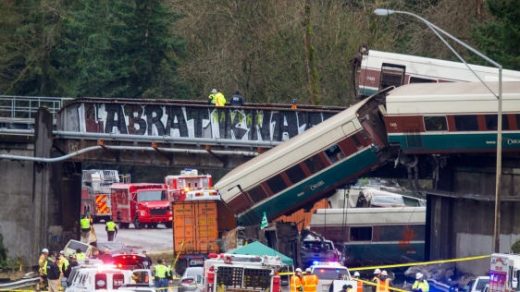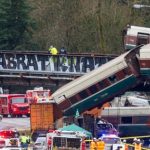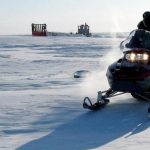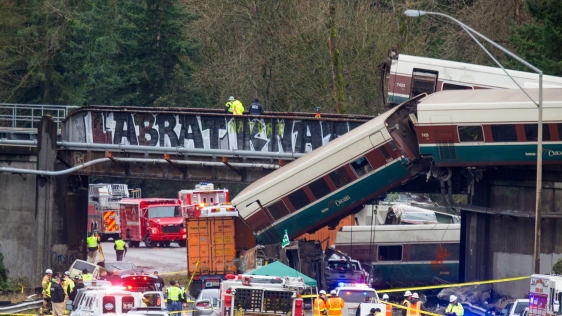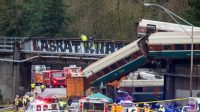Before Fatal Train Derailment, Officials Warned Of High-Speed Deaths
The Amtrak train that derailed south of Seattle on Monday, killing a number of passengers and injuring dozens as it careened off a highway overpass, was on an initial run as part of a fast service that had previously led local authorities to warn of fatalities.
It’s still not clear what caused the accident, investigators said on Monday evening. The maximum speed on that stretch of track is 79 mph, and the speed limit on the curve where the train derailed has a top speed of 30 mph, state transportation department spokeswoman Barbara LaBoe told The Seattle Times. But Transitdocs.com, a website that tracks train locations using data from Amtrak’s train tracker service, said that Train 501 was going 81.1 mph moments before the derailment, the Associated Press reported.
In an initial emergency call at 7:37 a.m., captured by Broadcastify.com, an operator at the rear of the train described the damage. “We’ve got cars everywhere and down onto the highway,” he radioed.
The new service was meant to provide what the state transportation department said was a time savings of 10 minutes and better on-time reliability. The $180.7 million upgrade was, according to the Associated Press, “designed to speed up service by removing passenger trains from a route along Puget Sound that’s bogged down by curves, single-track tunnels and freight traffic.”
The route is the same that Sound Transit, the Seattle regional transit agency, uses for Sounder commuter rail service to Lakewood. The tracks had been adapted for use by higher-speed trains, and authorities said they had been tested in recent weeks ahead of today’s inaugural public run.
More photos from scene of Amtrak train derailment pic.twitter.com/yWEJejp1H2
— Pierce Co Sheriff (@PierceSheriff) December 18, 2017
Previously, officials—including those from Amtrak—had warned of the risks that fast trains posed to pedestrians and vehicles near rail crossings in particular. “We want to make sure as many people as possible understand what’s going on, understand we are starting a new service on December 18, and ensure that they know how to stay safe around the railroad tracks,” Janet Matkin of the Washington State Department of Transportation said at a public presentation earlier this month, according to a December 4 KOMO-TV report.
At that meeting, Don Anderson, the mayor of Lakewood, Washington, repeated concerns he had raised for years, warning that deaths were inevitable. “Come back when there is that accident, and try to justify not putting in those safety enhancements, or you can go back now and advocate for the money to do it, because this project was never needed and endangers our citizens,” Anderson said, according to KOMO.
Among the safety improvements he’d been advocating for were grade separations, like overpasses, to keep trains away from cars and pedestrians. (Monday’s derailment occurred as the train was crossing an overpass; cars spilled onto the highway below.)
In 2013, Lakewood’s concerns about the high-speed service led the city to sue the Washington State Department of Transportation in an effort to halt the project, on the grounds that it had not undergone sufficient environmental review. As the Seattle Times reports:
The lawsuit was dismissed on a summary judgment motion in 2014. [Mayor] Anderson said the city lost its case in part because the law preempts cities and towns from regulating rail lines.
Anderson said he also viewed the project, which received money from the 2009 federal stimulus package, as a waste of taxpayer money because the rail line doesn’t carry what he views as a significant number of travelers.
Lakewood pressed for additional money for safety projects along the new line, he said, and received some concessions for crossing improvements and fencing. Anderson said a brand-new high-speed rail project would not have allowed so many at-grade crossings in a suburban setting–they’d instead have been moved to tunnels or overpasses–but that the Amtrak spur was grandfathered out of some of those requirements because it runs along an existing line.
“There is a reason the word ‘railroaded’ is in our vocabulary. They wrote the rules,” he said.
In a December 13 tweet, nearby military facility Joint Base Lewis-McChord also posted a safety video about the new service, warning drivers about stopping on the tracks.
HIGH SPEED TRAINS BEGIN RUNNING MONDAY!! Check out this important safety message from #JBLM regarding rail safety and remember, NEVER stop on the tracks! @I_Corps @62dAirliftWing @7thID pic.twitter.com/R8YeTk9eCc
— JB Lewis-McChord (@JBLM_PAO) December 13, 2017
The derailment, which occurred at Interstate 5 near the city of DuPont, impacted 13 cars in total; According to Amtrak, there were approximately 78 passengers and five crew members on board.
Amid conflicting reports about injuries and possible causes, authorities told reporters at a Monday evening press conference that the accident had so far led to three fatalities, over 100 people brought to nearby hospitals, and “a lot” of critical injuries. On Monday, the National Transportation Safety Board said it had begun its own investigation into the cause of the derailment.
Trump’s Budget Cuts Hit Amtrak
In his first tweet about the accident on Monday, President Trump suggested that his infrastructure plan would have prevented the fatal crash; he followed that with another tweet 10 minutes later, offering condolences to the families of those killed.
The train accident that just occurred in DuPont, WA shows more than ever why our soon to be submitted infrastructure plan must be approved quickly. Seven trillion dollars spent in the Middle East while our roads, bridges, tunnels, railways (and more) crumble! Not for long!
— Donald J. Trump (@realDonaldTrump) December 18, 2017
My thoughts and prayers are with everyone involved in the train accident in DuPont, Washington. Thank you to all of our wonderful First Responders who are on the scene. We are currently monitoring here at the White House.
— Donald J. Trump (@realDonaldTrump) December 18, 2017
But rather than upgrading long-distance routes like the one that Train 501 traveled, the Trump administration’s budget proposals have proposed deep cuts: Trump’s $16.2 billion discretionary spending proposal for transportation represents a 13% reduction over 2017 numbers, with $928 million slashed from transit construction grants, or nearly half of what Congress had appropriated for this fiscal year, as the Washington Post reported in May.
The Trump proposal also called for a $630 million reduction in subsidies for long-distance Amtrak routes. Instead, the administration said Amtrak should focus on improving its Northeast Corridor service, which serves more densely populated areas between Washington and Boston.
The Trump budget document called long-distance Amtrak trains “a vestige of when train service was the only viable transcontinental transportation option,” and included a litany of complaints about Amtrak’s long-distance service: Its trains are on schedule only 55% of the time, account for 15% of Amtrak’s ridership but 38% of the system’s operating costs, and have had net operating losses of about $500 million annually over the past decade, according to the budget document.
Sean Jeans-Gail, vice president of the National Association of Railroad Passengers, told the Post in May that the budget cuts to transit and Amtrak would be particularly harmful to commuters, the elderly, and people in rural areas. A reporter asked him what he saw in the budget proposal. “I’m just looking at the smoking wreckage,” he said.
Bloodworks Northwest, an area blood bank, is collecting donations; find a donation site or mobile blood drive here. KING-TV said Bloodworks had already provided over 150 units of blood to area hospitals to help victims of the derailment.
Updated 5:00 p.m. PT with new details about the speed limit where the train derailed.
Fast Company , Read Full Story
(29)

